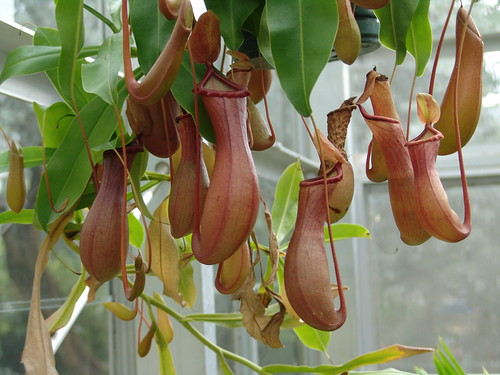 |
| Peaks and valleys: The Google books Ngram Viewer search I performed. Smoothing = 2. |
First, a caveat. The limitations of this search are obvious: the results returned are restricted to books in the public domain or ones Google has digitized, there is significant duplication in some of the more popular books that were reprinted multiple times and leads to artificial peaks, and errors in the OCR text can cause problems.
Given all that, though, what can we learn from my search? It would appear that almost no one was using either of these terms to describe flesh-eating plants prior to about 1870. This is consistent with what we know about botanical knowledge from that period. For example, when the Venus flytrap was first discovered and passed around from botanist to botanist, it was mostly an oddity that the less-than-prude educated men of the time giggled at, but there was only little speculation on its function and they didn't have the language to describe it quite yet. It also took decades from its initial discovery for live plant material to reach European botanists.
Enter, of all people, Charles Darwin.
 |
| Ready for dinner: Illustration of Dionaea muscipulafrom Darwin's Insectivorous Plants (1875). |
At the same time, though, "carnivorous plants" was also favored, with both terms receiving similar hits and possible even in the same books. Further Google Scholar searches, unfortunately not indexed by the Ngram Viewer, reveal early 1860s and '70s papers that mention either terms, but none before that. Even the trusty Oxford English Dictionary lists the first mention of "carnivorous" in a botanical context as occurring in 1868 and Sir John Lubbock's 1874 On British Wild Flowers Considered in Relation to Insects as being one of the earlier mentions of "insectivorous plants."
 |
| Nepenthes by Drew Avery. |
And finally, since about the 1940s, the term insectivorous has fallen out of favor among botanists. This may have been because studies began revealing that many insectivorous plants spend a lot of their time capturing things other than insects, such as spiders. And while the exceptions such as the odd mouse or two found in a Nepenthes pitcher don't matter all that much, for the most part the prey of these plants belong to the broader Arthropod phylum and not the more restricted insect class. To be nit-picky, it's technically correct to call these plants insectivorous, as insects are part of their diet, but that excludes the other organisms they may catch with decent frequency. The broader term carnivorous plant is now perhaps finally replacing the other, though "insectivorous plant" persists to some degree.
For more information on Google's Ngram Viewer, see this TED Talk: What we learned from 5 million books.
No comments:
Post a Comment